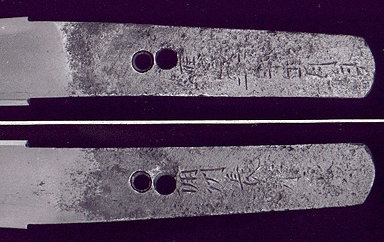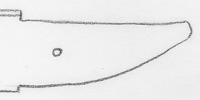Nakago (中心
or 忠) -
Tang shapes on Japanese Swords
|
The tang or the part of the Japanese blade
that goes into the handle (tsuka) or pole is called a nakago. There are
several shapes (gata) that vary in length, curvature, thickness. Many are
indicative of a school, Den or smith. Below are examples of some of these. |
|
|
| Sakibari (先張り),
kakubari (角張り) or shippari (尻張り)
Refers to a wide nakago with almost parallel edges. Seen mainly on Bizen
blades.
|
|
|
| Kijimomo-gata
|
|
|
| Funagata
(舟形)
Refers to a short and stubby nakago, in the shape of a ship bottom, that
bulges strongly outward on the ha side, or edge. Seen commonly on Soshu
style tanto.
|
|
|
| Furisode-gata
|
|
|
| Gohei-gata (御幣形)
A nakago shape with paired steps on each side (mune & ha). This name refers
to the strips of white paper hung at the enterance of Shintō shrines. Seen
in the works of Ise no Kami Kuniteru.
|
|
|








